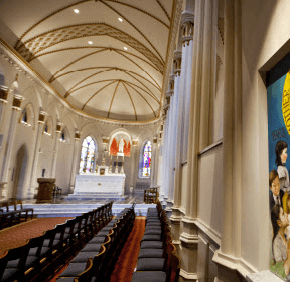By Elizabeth Lowe
Twitter: @ReviewLowe
The chapel at the first Catholic seminary in the U.S. – which has seen the likes of Cardinal James Gibbons and St. Elizabeth Ann Seton – has been restored to the way it looked during its centennial year in 1908, albeit while adding modern amenities.
The restoration of St. Mary’s Chapel at St. Mary’s Spiritual Center and Historic Site in Baltimore was celebrated Sept. 8 – the Feast of the Nativity of the Blessed Virgin Mary – with midday prayer.
Retired Auxiliary Baltimore Bishop William C. Newman was the celebrant.
Cardinal William H. Keeler, archbishop emeritus of Baltimore; Baltimore Auxiliary Bishop Denis J. Madden; Bishop W. Francis Malooly of the Diocese of Wilmington and formerly of the Archdiocese of Baltimore; Sulpician Father David D. Thayer, a member of the Sulpician General Council; and Sulpician Father Thomas R. Ulshafer, provincial superior of the province of the U.S. of the Society of St. Sulpice, were among those who attended the celebration.
A committee of alumni from the former St. Mary’s Seminary on Paca Street – priests and lay people – worked on the restoration.
Committee member and 1966 alumnus Monsignor Lloyd E. Aiken, pastor of St. Charles Borromeo, Pikesville, and Sacred Heart, Glyndon, said that when he was a seminarian, the chapel “was the center of seminary life.”
Until the seminary’s Paca Street location closed in 1969, philosophy classes were held there while theology classes were held at the seminary in Roland Park, which opened in 1929, said Sulpician Father John C. Kemper, executive director of the Mother Seton House and St. Mary’s Spiritual Center and Historic Site.
“The transformation of the site in the past five years has been nothing short of awesome,” Father Kemper said.
The site, which predates the nearby Basilica of the National Shrine of the Assumption of the Blessed Virgin Mary, was dedicated in 1808.
The four-phase project, which spanned eight years, included a new roof, visitor’s center and the chapel’s restoration, among other improvements, said Father Kemper, the committee’s facilitator. The restoration of the chapel interior cost more than $1 million.
“This has truly been a labor of love,” Father Kemper said.
The chapel’s restoration included new paint, ADA accessibility and the installation of a new marble floor and marble altar, Father Kemper said.
Two side altars, which came from a closed Catholic church in Mount Carmel, Pa., form the new large altar, Father Kemper said. A marble mason called it “anything short of a miracle” that the new altar worked in the space, Father Kemper said.
He said it evokes 1908, the site’s centennial and the time period which offered the greatest historical record.
The site “really is a springboard into life in Baltimore in the 1800s,” Father Kemper said. “This is part of what our Holy Father Pope Benedict (XVI) talks about – the New Evangelization. I can’t imagine how people could come here and not be impressed by the stories of people of faith.”
Mother Seton, the first saint born in the United States professed her first vows at the site. Cardinal Gibbons studied there and was ordained in St. Mary’s Chapel. Other historical figures associated with the site include Archbishop John Carroll, Sister Theresa Maxis Duchemin and Mother Mary Elizabeth Lange.
“When you connect the dots of history,” Father Kemper said, the site is a very important part of “the history of the Catholic Church in the United States. We’re doing all we can to make it public.”
If you go
The St. Mary’s Spiritual Center and Historic Site at 600 N. Paca St. in Baltimore is open to the public noon-3:30 p.m. Monday through Friday and 1-3 p.m. Saturday and Sunday. There is no admission fee.
Copyright (C) Sept. 23, 2012 CatholicReview.org


